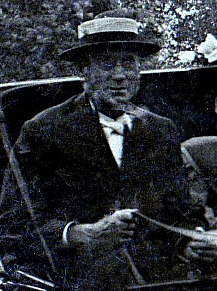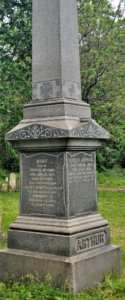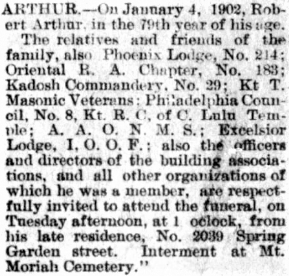Title: Coal dealer
Birthdate: February 23, 1823
Death Date: January 4, 1902
Plot Location: Section 43, Lot 13, southeast quarter

Not everyone who finds great success and prosperity begins their career as an accountant, but a strong foundation in financial matters is an obvious advantage. Robert’s start in business watching the numbers and balancing the books led to such prosperity that he left an estate worth nearly six million dollars in today’s money. What took him there was riding the wave of popularity in how people heated their homes in the last half of the 19th century: coal.
Robert was the first of six Irish-born children, all of whom left their parents behind at various times in the pursuit of happiness in Philadelphia. His petition to become a naturalized citizen in 1848 states he had lived in this country since at least 1843. He may have begun a “chain migration” where money is sent home so another family member can make the trip, and the pattern is repeated.
The 1850 census revealed he was married to Isabella Stuart and they had an eight-month-old child. Isabella’s gravestone says three children died in infancy before she died in 1852. She contracted tuberculosis at age 30. How did her husband concentrate on accounting under such circumstances?
He found support from his siblings and from his church family at Fourth Presbyterian, where his wife and children were initially buried. Three of his siblings, George, Jane, and John, had arrived in the late 1840s but their support was only for a short time. Jane died in 1856, followed by John in 1859 and George in 1862.
Meanwhile, Robert met and married Mary Scott in 1854. By this time he began selling coal and did quite well for himself. A live-in servant is listed in his household on the next census, plus there were now three children. Mary had a total of eight children, all baptized at Fourth Presbyterian Church, but three died in infancy and one at age 20.
From the time he started his coal business it was known as “Robert Arthur & Bro.” The brother being referred to may have been George, keeping the title in memory of the one who was closest to him in age. Or, he may have meant his other brother James. His occupation was almost always listed as a driver, so he could have been the one who  delivered the coal to customers’ homes. This is how the partnership was listed in city directories for close to 30 years.
delivered the coal to customers’ homes. This is how the partnership was listed in city directories for close to 30 years.
Mary lost a battle with gastritis and died in 1871, so Robert found a third bride at Fourth Presbyterian the following year. He and Elizabeth had one son in 1878. Alex was seven years old when his mother died of breast cancer, but there were still two half-sisters at home, besides the domestic help.
Robert’s brother, James, died in 1899 but it appears the coal business may have been sold by then. It was the same year he moved to a pricey home at 2039 Spring Garden Street, just up from the Ben Franklin Parkway.
 Alex became a doctor and was still at home with the two half-sisters when their father died in 1902. There were two other brothers, a postmaster and a plumber. His will stated they were to each receive a number of properties he owned, $2000 in cash, and share in a $25,000 annuity, with other funds going to his last remaining sister and several charities.
Alex became a doctor and was still at home with the two half-sisters when their father died in 1902. There were two other brothers, a postmaster and a plumber. His will stated they were to each receive a number of properties he owned, $2000 in cash, and share in a $25,000 annuity, with other funds going to his last remaining sister and several charities. The will also refers to the number of “secret societies” and other organizations where Robert contributed his talent in accounting while serving as the treasurer for many of them.
The will also refers to the number of “secret societies” and other organizations where Robert contributed his talent in accounting while serving as the treasurer for many of them.
There are at least 12 names mentioned on the large obelisk over Robert’s grave. Many of those family members that were originally in the burial grounds of Fourth Presbyterian Church were supposedly reinterred at Mount Moriah.

Support the Friends of Mount Moriah
Help us in our mission to restore and maintain the beautiful Mount Moriah Cemetery by donating to our cause or volunteering at one of our clean-up events.

